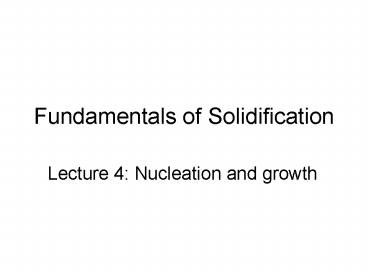Fundamentals of Solidification - PowerPoint PPT Presentation
1 / 44
Title:
Fundamentals of Solidification
Description:
Outer chilled zones. re-melted? Pouring temperature. survived? ... Chilled zone. Fine equiaxed grains. Pure substance: Continuous shell. Solution: Particles ... – PowerPoint PPT presentation
Number of Views:161
Avg rating:3.0/5.0
Title: Fundamentals of Solidification
1
Fundamentals of Solidification
- Lecture 4 Nucleation and growth
2
Outline
- Introduction
- Homogeneous nucleation
- Heterogeneous nucleation
- Growth and microstructure
- Summary
3
Introduction
- There are two types of solidification
- Glass formation
- Physical properties such as viscosity change
smoothly across the solidifying region - Phase transition
- Some physical properties change abruptly, such as
viscosity, heat capacity
4
Temperature vs. time in glass solidification and
phase transition solidification
5
Viscosity vs. temperature in glass solidification
and phase transition solidification
(a) Glass solidification (b)
Phase-transition solidification
6
Density vs. temperature in glass solidification
and phase transition solidification
7
Heat capacity of Fe
8
Introduction
- Solidification by phase transition is modelled as
two stage - Nucleation
- Homogeneous nucleation
- Heterogeneous nucleation
- Growth
9
Homogeneous nucleation
10
Homogeneous nucleation
- No preferred nucleation sites
- Spontaneous
- Random
- Those of preferred sites
- Boundary
- Surface
- Inclusion,
11
Local free energy change
1. Liquid to solid
2. Interface
12
Local free energy change
Spherical nucleus
13
Single nucleus
14
Critical radius
15
(GL-GS) vs. supercooling
solid
Free energy density
liquid
temperature
Free energy density vs. temperature
16
Parameters
For FCC Copper, r?1 nm, which contains 310 Cu
atoms in each nucleus.
17
System free energy
- Ideal solution Particle of different sizes
- ni particles with each contains i atoms
- n particles with each contains 1 atom
18
Number of nuclei
- At equilibrium
19
Number of nuclei
when
Boltzmann formula
Critical nuclei
20
Heterogeneous nucleation
- Nucleation site
- Mold walls
- Inclusion
- Interface
- Surface
- Impurity
21
Heterogeneous nucleation
22
Heterogeneous nucleation
Force equilibrium
where ?IL, ?IN and ?NL are the interface energies
of inclusion-liquid, inclusion-nucleus and
nucleus-liquid, respectively. ? is the
nucleus-inclusion wetting angle. The nucleus is a
spherical cap of radius r.
23
Free energy change
24
Free energy change
Using
25
Thermodynamic barriers
Heterogeneous nucleation barrier
Homogeneous nucleation barrier
26
Thermodynamic barrier vs. wetting angle
27
(No Transcript)
28
Number of nuclei with critical radius
where ns is the total number of atom around the
incubating agents surface in liquid.
29
Inoculating agents
- Small interface energy
- Similar crystal structure
- Similar lattice distance
- Same physical properties
- Same chemical properties
30
Casting refinement
- Adding inoculating agents
- Overheat might melt the agents
- Surface refinement
- Coat agents on mold walls
- Pattern induced solidification
31
Growth and microstructure
T. F. Brower and M.C. Flemings, Trans. AIME, 239,
1620 (1967)
32
Growth and microstructure
H.B. Dong and P.D. Lee, Acta Mater. 53 (2005) 659
33
Outer chilled zones
34
Outer chilled zones
35
Outer chilled zones
36
Outer chilled zones
Pure metals Formation of shell because
temperature gradient is the key factor in grain
growth.
37
Outer chilled zones
Pouring temperature
re-melted?
survived?
38
Microstructure of ingot
- Chilled zone
- Fine equiaxed grains.
- Pure substance Continuous shell.
- Solution Particles
- Particles flushed away from wall into the central
- Re-melted
- Survived nucleus
39
Intermediate columnar zone
The grain is overtaken by neighbors.
Columnar grains grows
40
Intermediate columnar zone
Growth and overtaken
41
Intermediate columnar zone
Columnar growth blocked
42
Central equiaxed zone
- Equiaxed grain
- Nucleation
- Supercooling
- Falling particles
- Dendrite fragments
- Elevated pouring temperature
- Larger equiaxed grains
43
Structure and properties
- More columnar zone
- Anisotropic properties
- Magnetic materials
- Turbo blade.
- More equiaxed zone
- Isotropic properties
- Less segregation
44
Summary
- Casting
- Heat management
- Thermodynamics
- Nucleation and growth































